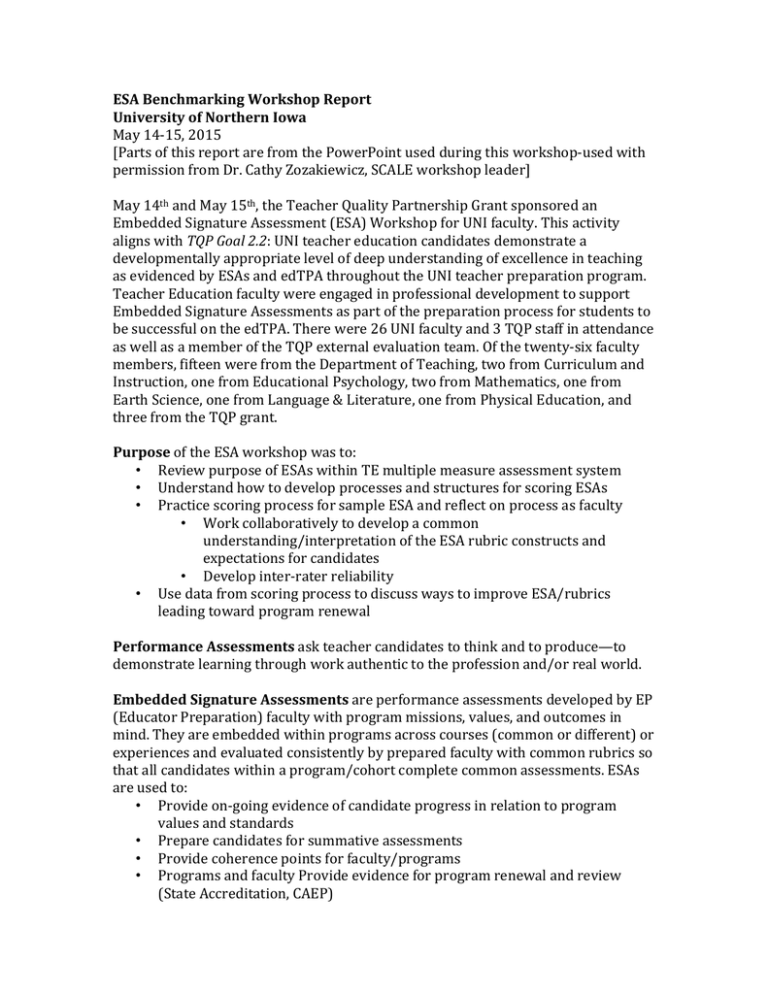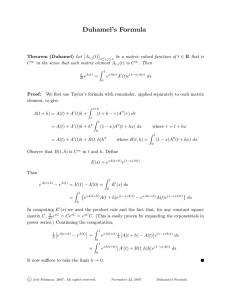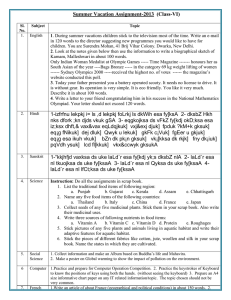Document 11520459
advertisement

ESA Benchmarking Workshop Report University of Northern Iowa May 14-­‐15, 2015 [Parts of this report are from the PowerPoint used during this workshop-­‐used with permission from Dr. Cathy Zozakiewicz, SCALE workshop leader] May 14th and May 15th, the Teacher Quality Partnership Grant sponsored an Embedded Signature Assessment (ESA) Workshop for UNI faculty. This activity aligns with TQP Goal 2.2: UNI teacher education candidates demonstrate a developmentally appropriate level of deep understanding of excellence in teaching as evidenced by ESAs and edTPA throughout the UNI teacher preparation program. Teacher Education faculty were engaged in professional development to support Embedded Signature Assessments as part of the preparation process for students to be successful on the edTPA. There were 26 UNI faculty and 3 TQP staff in attendance as well as a member of the TQP external evaluation team. Of the twenty-­‐six faculty members, fifteen were from the Department of Teaching, two from Curriculum and Instruction, one from Educational Psychology, two from Mathematics, one from Earth Science, one from Language & Literature, one from Physical Education, and three from the TQP grant. Purpose of the ESA workshop was to: • Review purpose of ESAs within TE multiple measure assessment system • Understand how to develop processes and structures for scoring ESAs • Practice scoring process for sample ESA and reflect on process as faculty • Work collaboratively to develop a common understanding/interpretation of the ESA rubric constructs and expectations for candidates • Develop inter-­‐rater reliability • Use data from scoring process to discuss ways to improve ESA/rubrics leading toward program renewal Performance Assessments ask teacher candidates to think and to produce—to demonstrate learning through work authentic to the profession and/or real world. Embedded Signature Assessments are performance assessments developed by EP (Educator Preparation) faculty with program missions, values, and outcomes in mind. They are embedded within programs across courses (common or different) or experiences and evaluated consistently by prepared faculty with common rubrics so that all candidates within a program/cohort complete common assessments. ESAs are used to: • Provide on-­‐going evidence of candidate progress in relation to program values and standards • Prepare candidates for summative assessments • Provide coherence points for faculty/programs • Programs and faculty Provide evidence for program renewal and review (State Accreditation, CAEP) UNI faculty working with Dr. Zozakiewicz have developed the following ESAs: 1. Planning Design for L2 Candidates 2. Analyzing Data and Providing Feedback 3. Deepening Learning through Effective Questioning 4. Developing Leadership through Communication and Collaboration Skills 5. Planning and Analyzing Student-­‐Focused Learning 6. Academic Language (under development) The developed ESAs were piloted during the 2014-­‐2015 years. Table 1 documents the pilot delivery timeline. Table 1 ESA Pilot Timeline ESA Piloted When Sections Courses/ Sequence L2 Planning Spr15 11 1 Level 2 ST-­‐Focused Spr15 1 SCI Methods Level 3 Effective Questioning F14, Spr15 F=1 S=4 F-­‐SCI S=Art,PE,Sci Level 1-­‐3 Analyzing Data Spr14 F14 Spr15 S14=2 sects F14=3 sects S15=6 sects Elem SCI Sec MTH Level 2/3 Leadership Spr15 6 Levels 1-­‐ 4 Workshop The goal of this workshop was to start the benchmarking process on developed ESA rubrics. The Level II ESA was used because it had a large pool of samples with multiple faculty using it. The content of the ESA was accessible to all faculty and it was a great example for discussion of revision and renewal. Also, the Level 2 faculty gave permission to use their pilot data. To do so, faculty used performance data located within Show Evidence to rate a student’s performance using the ESA rubrics. They were instructed to: • Review Rubric • Identify and Record Evidence (Use sources for each rubric) • Interpret Evidence by Mapping to Rubric Language and Level • Use Preponderance of Evidence as needed • Select a Score Following rating completion, consensus scoring took place. Group of 3 or 4 choose a facilitator to lead and document discussion. For each ESA the group discussed each rubric, using evidence form the source/s, and then came to consensus on a final score. They were encouraged to use the preponderance of evidence rule as needed. This rule, adapted from the edTPA, requires scorers to make decisions about a score level based on the “preponderance of evidence” provided by candidates and its match to the rubric level. When evidence falls across score points, scorers should use the following criteria while making the scoring decision: • A pattern of evidence supporting a particular score level should have a heavier weight than isolated evidence in another score level Upon completion, attendees’ discussion addressed both the faculty’s rating and that of the SCALE faculty. Interpretations of the each rubric’s intent were shared as the group came to consensus on the appropriate language. Faculty we asked to reflect upon the following questions: • What patterns did you notice about candidates’ responses (strengths/needs)? • What comments or questions emerged about the ESA and rubrics? • Where might this lead us in terms of revising the ESA and/or rubrics? • What might this mean for the program overall? Faculty were then asked to consider rubric revision based on what the ESA is measuring, candidate responses, evidence and to think about the following: • ESA tasks and performance outcomes • Redundancy • Priorities – what knowledge and skills are most important to measure • Level progressions • Evidence presented by candidates Extensive discussion resulted in an updated rubric for the ESA. Day Two During day two of the workshop, faculty went through the same process again using other samples. This was followed by discussion of next steps. Dr Zozakiewicz suggested the following steps be taken:. • Use data from scoring process to discuss program renewal • Begin to develop plans for ESA scoring process, structures and timelines • Purpose of ESAs (Benchmarks, Passing Standards…) • Timeline for Scoring to Calibrate and Review ESAs • Data Collection and Use Plan • Data Sharing – ESAs and edTPA • Program Renewal She also suggested critical decisions for ESA development that should be included in the ESA decision-­‐making process. These included: • Build faculty consensus about valued outcomes • • • Make decisions based on candidate performance data Sequence ESAs (and rubric criteria/levels) in ways that reflect candidate development Allow faculty autonomy in instruction supporting ESAs




